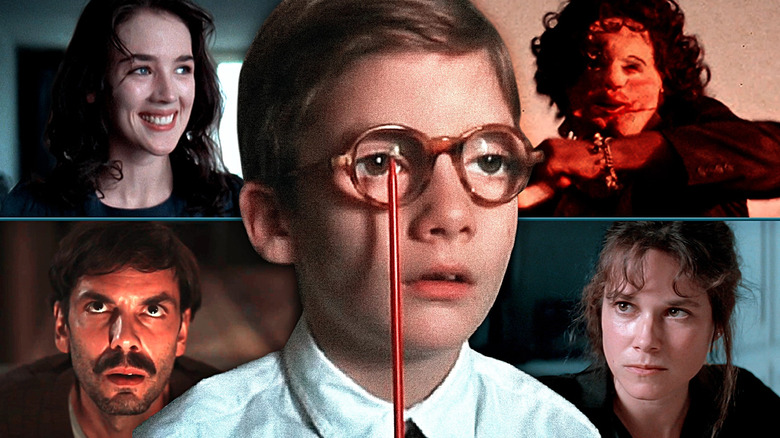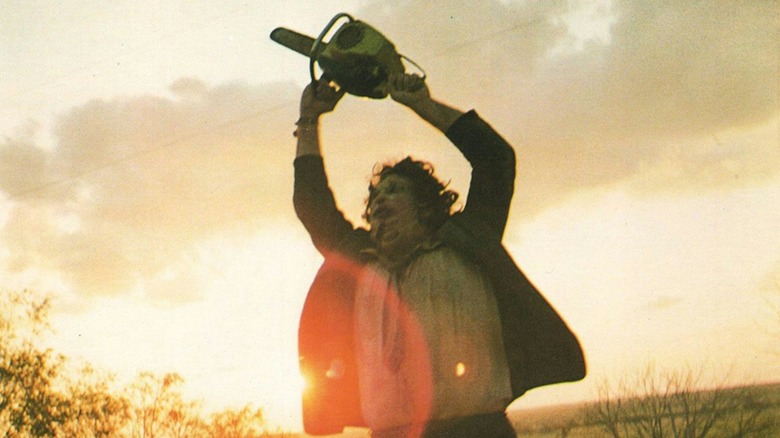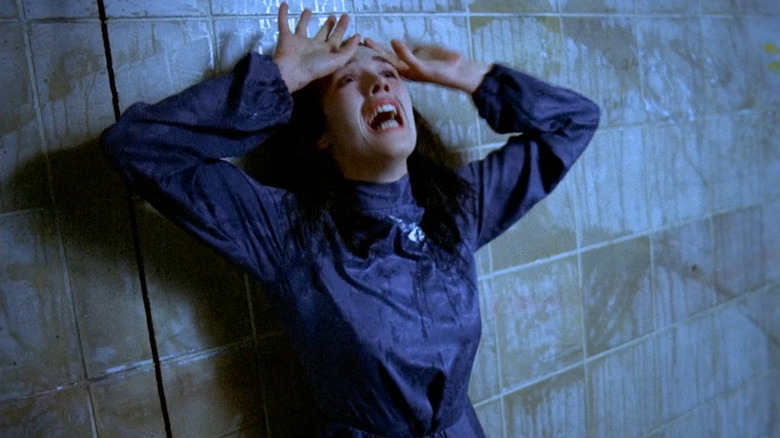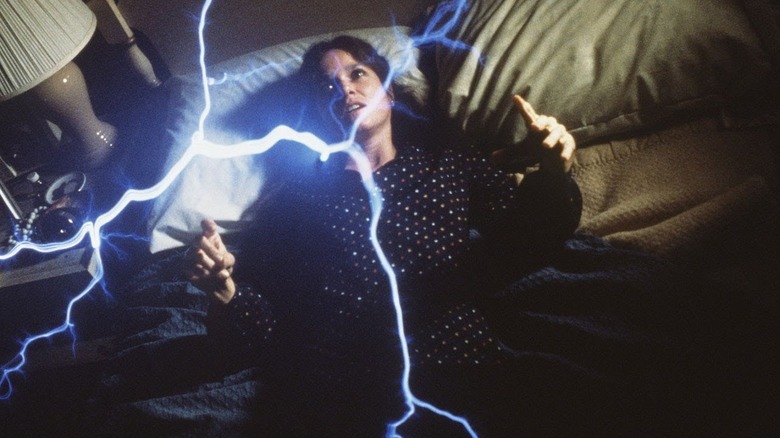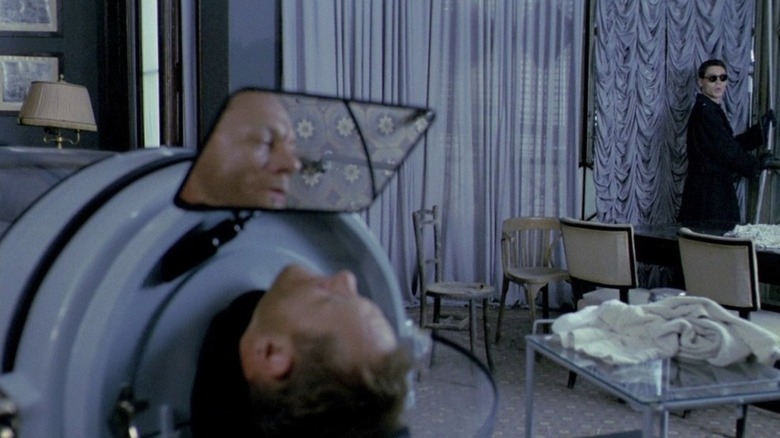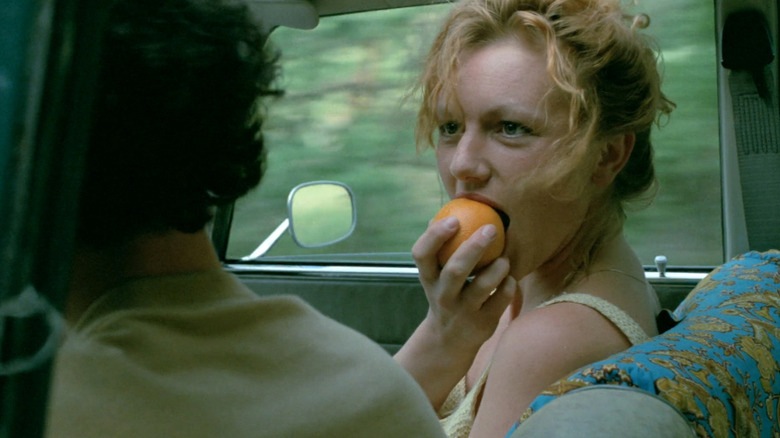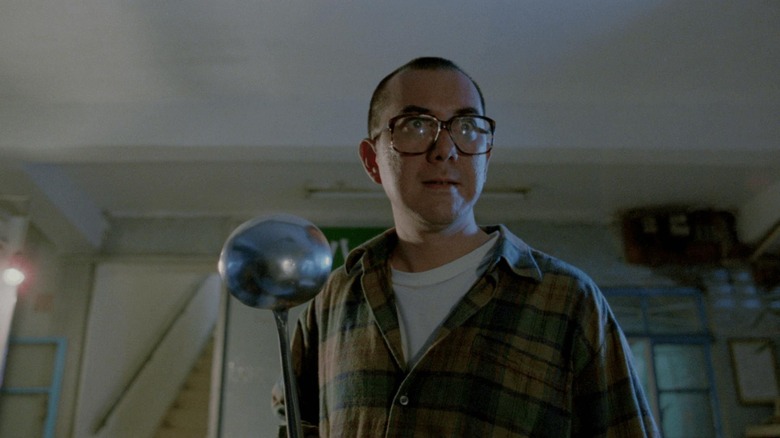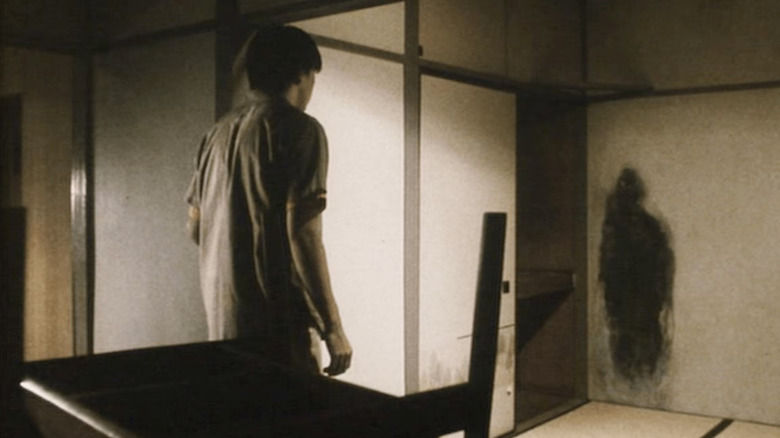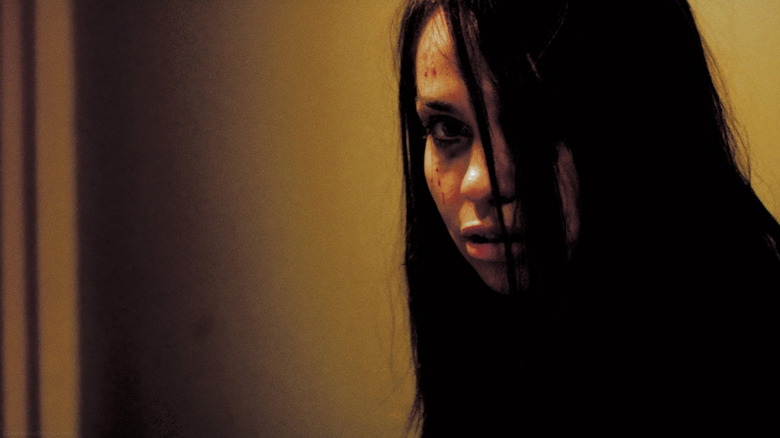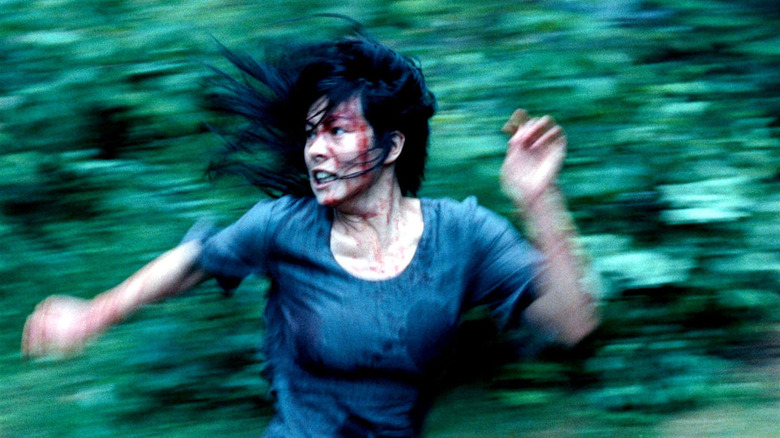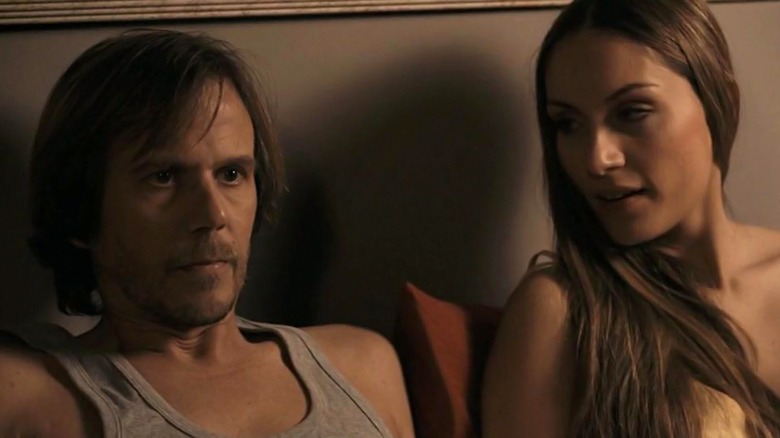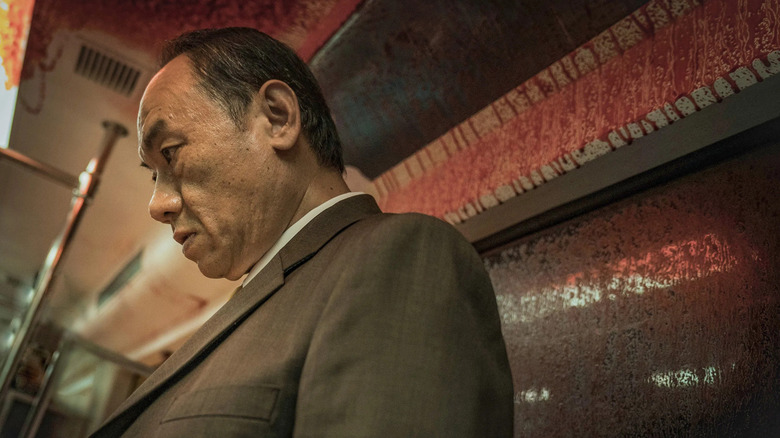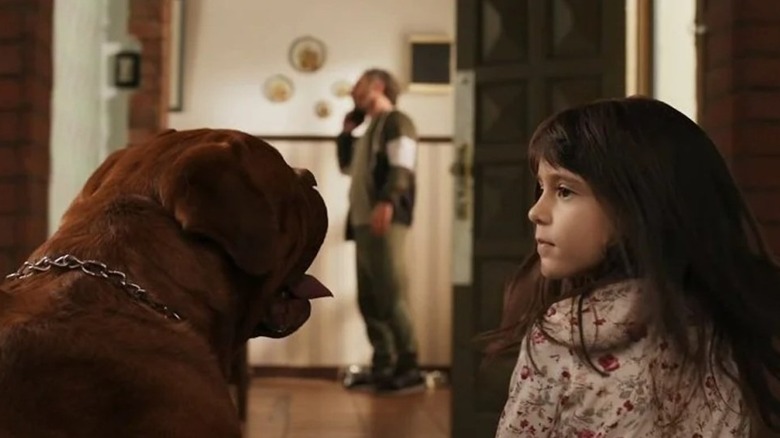15 Horror Movies So Disturbing You Will Only Watch Them Once
Let's get this out of the way right up front. Not every film on this list is disturbing to you in particular, and some of us have watched them multiple times. Calling a movie disturbing is no different than calling it funny, good, scary, or bad — they're subjective opinions that don't always hold true for other viewers. Still, the movies below succeed at getting under your skin to the point where they leave you some degree of worried, anxious, and unsettled.
It would be easy enough to list films featuring grotesque cruelties and vicious assaults, but there's more to being disturbed beyond mere violence. Sometimes it's the emotional or mental toll that weighs heaviest. The horror films below run the gamut when it comes to cataloging and exploiting the things that leave us disturbed and uncomfortable, even from the comfort of our own couches, with the result being that sometimes someone's first viewing will also be their last.
Now keep reading for a chronological look at 15 horror movies so disturbing that you will only watch them once.
The Texas Chain Saw Massacre
A group of friends on a road trip through rural Texas make the altruistic mistake of picking up a deranged hitchhiker who quickly commits an act of violence. Then things get even worse.
Tobe Hooper's mid 1970s shocker kicked off a bloody, gory franchise that's still slicing and dicing up screens half a century later, but none have had the power to disturb like this relatively bloodless original. Hooper chooses to show very little onscreen violence, but "The Texas Chain Saw Massacre" is so intense that it feels like we're seeing so much more than we are.
From the jump scare of Leatherface slamming open a steel door to the visceral terror of being chased by a chainsaw-wielding madman wearing a dead person's face, Hooper's film crafts an atmosphere that's inherently upsetting in its existence (something evident in its production). The lone survivor wakes to find herself strapped to a chair at the dinner table as the deranged family gleefully awaits a taste of her blood, and their dynamic is nothing less than a nightmare tableau.
Possession
Mark is a spy for the West, but it's his wife's secrets that capture his attention. He thinks she's cheating on him, but the truth is far, far worse.
"Possession" seems straightforward enough with its story about a man, his wife, and the ugliness of divorce, but director Andrzej Zulawski has little interest in simple and straightforward. Like David Cronenberg's "The Brood," this is a film made by a man still feeling the rawness of his own marital separation, and that combustible, confused blend of sadness, anger, and uncertainty results in a film that feels like a heart and mind splayed open to reveal the ugly wonders within.
Sometimes a movie captures something that feels... wrong, or off. Something that feels like we shouldn't have been made witness to it. This film offers up imagery that sears its way into your brain with monsters, murder, and metaphor, but the emotionally upsetting and endlessly disturbing core of it sits in Isabelle Adjani's performance. Specifically, her complete mental breakdown in the subway feels like we're witnessing an intimate unraveling, a private collapse of someone's very being, but you cannot look away.
The Entity
Carla is a single mother who's attacked one night by a seemingly invisible "man," but even as the sexual assaults continue, she finds it increasingly impossible to convince others that it's not all in her head.
The horror genre is filled with outright scary ghost stories, but none of them have the power to disturb like "The Entity." The supernatural being here isn't interested in simply spooking the living — it wants to terrify Carla to the point where she has no expectation or understanding of safety and security. These assaults are intimate, and their effects are emotionally and mentally devastating to character and viewer alike.
Director Sidney J. Furie brings a technical prowess and blunt style to the film making things all the more upsetting and frightening. We see the attacks, and the frustration grows as men — a boyfriend, authorities, doctors — dismiss her claims as a result of past trauma, promiscuity, and the simple fact that she's a woman. That real world dismissal makes the horror that much worse leading to an ending that saddens, shocks, and passes judgement on society's failure.
In a Glass Cage
Klaus was a doctor in Nazi Germany, but he resides now in Spain, confined to an iron lung after an incident left him immobile. A young man arrives to help care for him, but a shared past means that care will take a horrifying form.
All of the films on this list are disturbing in one way or another, but "In a Glass Cage" reaches some highs (lows?) that only a few others here are equally capable of. Klaus is a very bad man, someone who abused and assaulted children on an epic scale, who now finds himself defenseless. It's no twist that the new caretaker is actually one of the doctor's former victims, but what happens next is as upsetting as it is unexpected.
Those expecting a simple and satisfying revenge tale (like these) should look elsewhere as this is something far more deranged and disturbing. While not particularly graphic, your mind can't help but "see" the vile, foul actions that upset both on their face and as a commentary on the cycle of violence and cruelty that is human history.
The Vanishing (1988)
A young couple on vacation are separated when she disappears at a gas station. The years pass, there's simply no trace of her, and it continues to eat away at him to the point that he'll go to extraordinary lengths to find answers.
George Sluizer's "The Vanishing" is not a film interested in delivering catharsis to anxious viewers, and make no mistake, its slowly twisting narrative will leave you incredibly anxious and unsettled. Like Rex, we're desperate to know what happened to his girlfriend, Saskia, and it's that need that drives him, us, and the story straight into the heart of darkness.
It's that unknown, that unanswered question that gnaws away at any hope for calm and sanity, that can't help but disturb. Is she alive? Is she suffering? Can she be saved? What would you do for the chance at answers? Sluizer remade his own film five years later for English-speaking audiences, but it wholly betrays his original by offering a Hollywood escape from the emotionally draining nightmare meaning don't expect it to appear on our list of horror remakes that surpass the original.
Afraid of the Dark
Recent attacks against blind women has young Lucas fearful for his mother even as his own prurient interests see him spying on women without their knowledge. Violence inevitably arrives, but it shakes things up in wholly unexpected ways.
What disturbs one person might mean nothing to the next. Mark Peploe's "Afraid of the Dark" is an example of that niche approach as the anxiety-inducing angle here involves a fear of not being able to see. The film works best for those of us with poor vision as we live day to day knowing how precious sight really is, and that fear filtered through an already awkward and introverted young boy leads to an unnerving and anxious tension.
The film features a twist, of sorts, halfway through that won't be revealed here, but it's the moment that truly drives home its themes and fears. There's something both exciting and terrifying to a child about adulthood, and the latter is susceptible to all manner of anxieties easily exaggerated by a child's imagination. Once felt as a child, the fear can remain a disturbing presence as an adult.
The Untold Story
Wong Chi-hang serves up some delicious pork buns in his restaurant, but maybe it's not actually his restaurant, and maybe that's not pork in those buns?
One of the many wickedly tasteless thrills in Herman Yao's "The Untold Story" is its most obvious — yes, that's actually human meat in those buns — but it's also ultimately, surprisingly, and happily the most pedestrian of the film's perversions. Fair warning, the film gets nasty with a quick but vicious assault, lots of messy violence, and a scene involving children that, well, is definitely not to everyone's taste.
For all of its wildly over the top violence and shenanigans, though, the driving force here remains Anthony Wong in the lead role. Yao's frequent muse — you'll want to immediately seek out their other exploitation classic, "Ebola Syndrome" — commits to the role and this character like his life depended on it, and the result is a frantic but sincere madness. Black comedy rears its head throughout, always walking the line between icky and entertaining, and Wong embraces it all with a mad smile and an evil glint.
Pulse (2001)
Ghosts are here, but rather than rearrange our belongings or diddle us in the night, they're imploring us to shed our lonely shells. The fear of a life lived alone leads to increased suicides, and soon it's the dead who are lonely no more.
Kiyoshi Kurosawa is a master of slow burn horror, and while that may feel like the antithesis of disturbing, those who give themselves over to "Pulse" are rewarded with some truly upsetting terrors. Our fear of being alone is very real, and while the internet is often credited as a way to bring people together, it unavoidably does so while keeping us apart.
People desperate for connection go online only to discover that the dead are riding those same ones and zeroes to assuage their own loneliness. Like an unintentional online dating service for the terminally depressed, the internet becomes a conduit for a shared dread over being alone. Scary, depressing, and ultimately disturbing, this is horror speaking to both heart and mind and reminding you that you are, and always will be, alone.
The Girl Next Door (2007)
It's the 1950s, and two orphaned sisters arrive in a small town to be looked after by their aunt. Unfortunately for them, the woman is sadistic and cruel beyond imagination.
Apologies for breaking the fourth wall here, but "The Girl Next Door" is the only film on this list that I won't be watching a second time. Critical concerns aside, it's a film purely about humankind's propensity for inflicting pain and cruelty on others. The victims here are the epitome of innocents, two girls already hurt by fate with the loss of their parents, now forced to endure suffering at the hands of a woman and the children under her control.
That last part is an additional twist of the knife as other kids are manipulated and unleashed to commit vile acts by an adult who knows better but refuses to act better. Worse, authorities refuse to believe what's happening until it's too late. Finally, and ultimately what makes this film all the more disturbing, is knowing that it's based on a true story. This will leave you down on people for months afterwards.
Inside (2007)
Sarah survives a car crash that leaves her husband dead and the unborn baby inside her a bit shaken. She trudges onward, but as the birth approaches, so does a maniacal woman who wants something she plans on acquiring with a very big knife.
The first of two films on this list from France's "New Extremity" movement, "Inside" ticks off boxes for a few different horror subgenres. Its siege on Christmas Eve makes it home invasion and Christmas horror, and interior shots involving the fetus lean into body horror at times as well. Ultimately, though, it's a mean, lean slice of survival horror as Sarah fights desperately for the life of both her and her unborn child.
Directors Julien Maury and Alexandre Bustillo aren't interested in wasting time, and the film's eighty-three-minute runtime offers up a tight and brutal nightmare for mothers — especially those who are currently expecting. The violence is unflinching in its brutality and gore, and disturbing possibilities swirl as it all descends into a vicious fight between two very determined women. This isn't a stylish action film. This is visceral horror that shocks and disturbs.
Martyrs (2008)
A young woman murders an entire family before calling on a friend for support. Reunited, the pair make plans for what's next, but they're interrupted by the arrival of a threat straight out of their nightmares.
Pascal Laugier's entry into the New French Extremity movement is as brutal as it is thought-provoking and one of the best horror films ever made. It's not often you watch a film pairing gory thrills and legitimate creepiness with philosophical ideas and arguments. Viewers are put through the ringer by the time the end credits roll, and that's when the conversations begin as to the true meaning of "Martyrs." There's no single interpretation, even if one stands more affecting and effective in its truth.
The film's exploration of pain as a gateway to martyrdom finds inspiration in stories about Catholic saints, and its villains are cut from that same cloth. Their faith is in need of shoring up, and they put innocents through hell hoping for a glimpse of heaven. It's a grueling watch leading to a tragic, engrossing ending that finds some degree of beauty in spite of itself. As with "The Vanishing" and "Inside," be sure to avoid the cowardly American remake of "Martyrs."
A Serbian Film
A retired porn star is offered a high-paying opportunity for one last film, and he reluctantly agrees knowing it will secure his family's financial future. He realizes too late that some people will do literally anything for money.
Of all the films on this list, "A Serbian Film" is the one most likely to get you shunned by family, friends, and strangers alike for sharing it or admitting you're a fan. It's understandable as director Srdan Spasojevic delivers sequences that cross boundaries of good taste and morality and arguably went too far. Listing them here is impossible, but just know that terrible things happen to adults, children, and babies alike. It's meant to shock and disturb, and even its biggest critics will typically concede it succeeds on both counts.
It's an angry film, mad at a world that not only allows such barbarity but that rewards it too through financial gain. Think of the worst possible thing a person can do to someone else, and just sit with the knowledge that someone somewhere would happily do it for the right price. I'm seemingly alone in seeing the film as a blackly comic tragedy, but trust me, that approach certainly makes it easier to digest.
Aniara
Earth is dying, and spaceships are transporting the last of humankind to a new home on Mars. One is knocked off course with no hope of correction, and the survivors are forced to consider their new place in the universe, both literally and metaphorically.
While some might argue the inclusion of "Aniara" on a list of horror films, a single watch should confirm it as a fantastically disturbing piece of existential, cosmic horror (on par with these). The idea of feeling lost, small, and alone is already a tough pill to swallow here on Earth, but floating listlessly through space with no hope of rescue magnifies those feelings exponentially.
That horror of the unknown — not of a monster or direct threat, but of the literal unknown in regard to where you are, what's going to happen, how you're going to survive, and what's awaiting you in the vast darkness — is immensely disturbing. The passengers have zero input or control over their lives, and as the years pass, the journey to nowhere becomes more harrowing, terrifying, and sadly honest about the divide between who we think we are and who we actually are.
The Sadness
A pandemic hits the populace of a Taiwanese city turning the infected into violently depraved threats. One young couple tries desperately to reunite across a blood-soaked city.
There have been a few horror films already that use our recent and very real Covid pandemic as a springboard for terror — "The Harbinger" and "Sick" are two wholly different but fantastic examples — but it's Rob Jabbaz's "The Sadness" that turns the exploitation dial all the way up to eleven. The film wastes no time separating our two protagonists and unleashing the infection, and as it spreads through the streets, the resulting carnage delivers a flood of blood, gore, and revulsion.
It's disturbing due to the graphic violence and bodily abuse including one scene involving a certain body part and an eye socket — make it a double feature with "A Serbian Film!" — but there's more here beyond the visceral violence. The infected show a visible disdain for other people's comfort, safety, and concerns, and while it's taken to exaggerated extremes, the throughline from our real-world selfishness is clear. It disturbs, because we know too many of us won't behave any better next time around.
When Evil Lurks
A small town descends into darkness as demonic possessions takes hold. The devilish entity is preparing to be birthed into a physical body even as some locals struggle to prevent it or escape.
Possession films come in all shapes and sizes, but the core truth through almost all of them is that hope rests in ritual and faith. Demian Rugna's masterful "When Evil Lurks" does away with those hopes through its admission that your god is dead and no amount of prayer can protect you. It's a terrifyingly disturbing concept that this growing evil is your new reality — whether you draw parallels to the real world or not — and the ensuing horror is all the more frightening and upsetting for it.
Rugna offers up minimal world-building, but it's more than enough to set the stage for a world where evil is growing unchecked. Read it as another pandemic-inspired tale of horror, or just immerse yourself in its nightmarish, Lucio Fulci-like madness — either way, some of its scenes are guaranteed to disturb.
